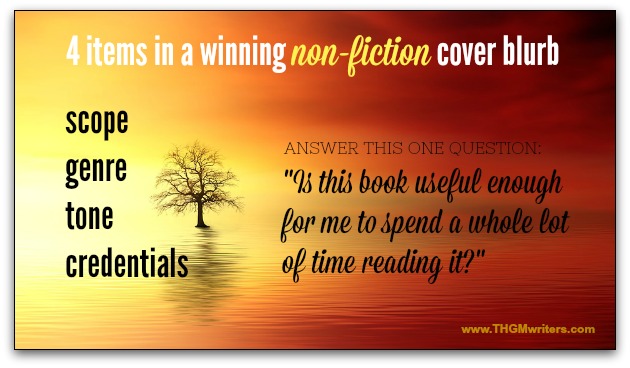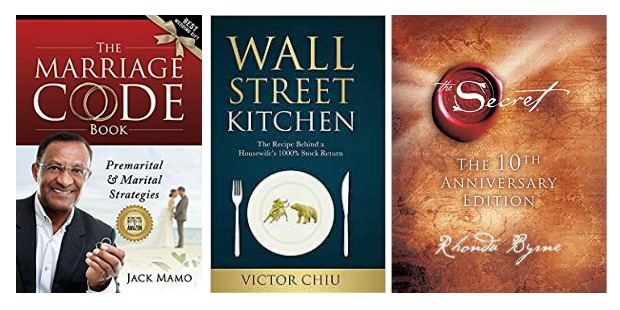If you plan to self-publish your non-fiction book, the most important thing you will ever write is the cover blurb for your book. Here’s how to do it right.
If you self-publish, you have to do it all. That includes preparing the cover of your book. Your book is like any other product – the packaging sells the cookies and the frozen dinner. Likewise, the cover sells the book.
People will get a feel for the book from the cover.
They’ll look at the pictures.
They’ll read the ingredients.
The ingredients are the author’s bio, the reviews and the back cover blurb of the book. Those few lines answer the book buyer’s critical question:
“Is this book useful enough for me to spend a whole lot of time reading it?”
Your back cover blurb is what they will use to decide whether your book is interesting enough or useful enough to buy.
- How to write a back cover blurb for a non-fiction book
- Four key questions your book blurb should answer
- Book cover blurb examples from good non-fiction books
- In a hurry? Skip straight to the video summary
The back cover blurb has to grab the reader’s attention from the start. It has to make them keep reading the blurb. Book buyers won’t read on if the first sentence fails to grab their interest.
TIP: Here is a tip that few people follow. It is a powerful tip. Write your book cover blurb first. Yes, before you write the manuscript. Perfect the blurb. Make it so drool-worthy that everybody will want to buy a copy of your book. Then, and only then, write the manuscript that fulfills the promise. Chances are, you will write a better book if you let the blurb guide you.
There is a big difference between writing a cover blurb for a novel and writing one for non-fiction. Let’s look at how to make your non-fiction cover blurb sell your book.
How to write a back cover blurb for a non-fiction book
Is writing a cover blurb for a non-fiction book different than writing one for a novel? Yes, but not always. Non-fiction can be divided easily into two categories: stories and topics.
Stories include biographies and historical accounts. These are non-fiction, but they tell a story. People look for many of the same things in non-fiction stories as they seek in fiction:
- surprises and anticipation
- a character they can identify with
- challenges and quests that seem larger than life
If your book is a story, you might want to use these fiction tips in my previous post to write the back cover blurb.
But most non-fiction books are topic books. They cover topics like business, health, computing or science. They come in a number of genres:
- how-to
- self-help
- advocacy
- hypothesis
- explanation
For instance, there might be five books on vaccinations on a bookshelf. The first might tell you how to create a vaccination or how to administer one (how-to).
The second might give advice on which vaccinations your family needs, when and where to get them, and what the risks and benefits might be (self-help).
The third book might tell you why vaccinations should be mandatory or why nobody should be forced to be vaccinated (advocacy).
The fourth book might explain an expert’s thought on what the future of vaccination holds (hypothesis).
The fifth book might recount all the research on vaccinations or explain the political issue in a dispassionate tone (explanation).
What these five types of non-fiction books have in common is that they are about topics. The reader doesn’t want suspense when buying a topic book. The reader wants to know what information is inside. Unlike for fiction, a non-fiction cover blurb should summarize the book.
Four key questions your book blurb should answer
What is the scope of the book? For instance, does the book cover all research on vaccines, or just adverse effects?
What is the non-fiction genre? Which of the five genres above best describes the content?
What is the tone of the book? Is the author supportive or opposed, excited or underwhelmed? Is the book serious or lighthearted, highly technical or easy for lay people to read?
Who is this guy, anyway? This is the big difference between fiction and non-fiction. With fiction, the author’s credentials don’t matter. True, a “best-selling author” has some appeal and will sell more books. But people will buy intriguing books from new authors, too.
People won’t buy a book on health or finance or carpentry or zoology or any topic unless they know that you really are an expert. They look for signs of your authority. Your cover blurb or cover bio must include your top three to five credentials:
- your education
- your accreditation
- related awards you have won
- how many books you have published
- how long you have been working in the field
- how many scholarly papers you have published
- the number of times you have been on TV to talk about the topic
As with fiction blurbs, be brief. Keep hyperbole to a minimum. Try to keep it below 150 words. Non-fiction readers might be a little more willing to work for it than fiction readers, but only a little. Just a smidgeon, really.
Make it easy for them to choose your book over the one next to it.
Non-fiction book cover blurb examples
Let’s look at a few non-fiction cover blurb examples .
Non-fiction cover blurb example from The Marriage Code
This one is from Jack Mamo’s The Marriage Code Book, which we worked on (this cover blurb is 179 words).
In the days we live in, the greatest worry that people planning on getting married have is about their future relationship due to the high divorce rate. For people already married, their fear is whether or not they can trust their partner and have a lasting relationship. In other words, no matter what stage a person and their partner are in, they’re likely worrying about relationship breakups and divorces; thinking that it might happen to them at any time. They wonder and ask if there is a solution to the problem. The author of the book “The Marriage Code Book” suggests that the content of his book provides a solution to this problem and shows that divorce does not have to happen.
“The Marriage Code Book: Pre-Marital Strategies” provides a simple yet thorough step-by-step strategy that will prepare couples as they go into their new marriage knowing that they do not have to be a part of the statistics. The book not only prepares newlyweds but it can also help married couples improve upon their faithfulness to one another.
This non-fiction cover blurb example covers the scope (how to protect a marriage). It covers the genre (how-to). It covers the tone (serious and easy for the average person to read). The author’s bio is separate, at the bottom of the back cover.
Non-fiction cover blurb example from Wall Street Kitchen
Here’s the blurb on another non-fiction book we worked on, Victor Chiu’s Wall Street Kitchen (185 words)
This award-winning book by author Victor Chiu combines sound business analysis provided by his mother, along with some down-to-Earth delicious recipes written in a slightly whimsical yet fundamentally educating style. Chiu shares his mother’s step-by-step recipe on how to multiply your wealth on the stock market.
Mrs. Chiu, an autodidact, gained experience with stock market investing and enjoyed sharing her revelations with her son, along with the latest delicacies from her kitchen. The combination of good advice coupled with savory meals made for a persona of a person which shaped Victor Chiu’s life in extraordinary ways.
His book celebrates the wisdom gained from his mother in which he shares with his readers, and fortunately at the end of the book are included recipes for the food so temptingly described.
A book that will satisfy your curiosity for sound financial modeling of investment strategies, while simultaneously making you hungry, Wall Street Kitchen has something for everyone. Advice on investing along with the double entendre theme analogy of food makes for a humorous read while humbly imprinting common sense principles for achieving success in the stock market.
This non-fiction book blurb example covers the scope (for beginners). It covers genre (how-to). It covers tone (down-to-earth). The author’s bio is at the bottom, below the blurb.
Non-fiction cover blurb example from The Secret
Although most bestsellers are fiction, let’s look at the back of one non-fiction bestseller: The Secret. I can’t find the back cover of the original anywhere. I’ll hazard a guess that the text I found on its website was the original blurb. If not, it should have been. It’s a crisp 117 words.
Author Rhonda Byrne, like each of us, has been on her own journey of discovery. In The Secret, she explains with simplicity the law that is governing all lives, and offers the knowledge of how to create – intentionally and effortlessly – a joyful life.
A number of exceptional men and women discovered The Secret, and went on to become known as the greatest people who ever lived. Among them: Plato, Leonardo, Galileo, Napoleon, Hugo, Beethoven, Lincoln, Edison, Einstein, and Carnegie, to name but a few.
Now for the first time in history, all the pieces of The Secret come together in a revelation that is life transforming for all who experience it.
This is The Secret to life.
This non-fiction blurb example covers the scope (one secret). It covers the genre (how-to). It covers the tone (lighthearted and easy to read).
Interestingly, there does not appear to be an author bio on the cover at all. The blurb just says that Ronda Byrne is an author.
As with fiction, there is no set formula for a non-fiction cover blurb. You have to think about what a potential buyer would want to know before making this decision:
“Is this book useful enough for me to spend a whole lot of time reading it?”
If you can answer that question well enough, you will make the sale. If you don’t answer that question well enough, another author will make a sale.
Ready to write your non-fiction book cover blurb? If not, why not take a trip to your local bookstore and check out a few back cover blurbs for inspiration?
VIDEO VERSION: How to write a non-fiction book cover blurb for the back cover of your book
- This video was made using InVideo.io



